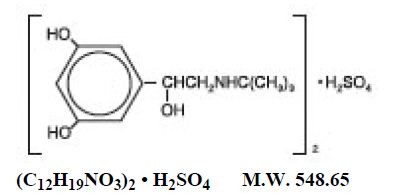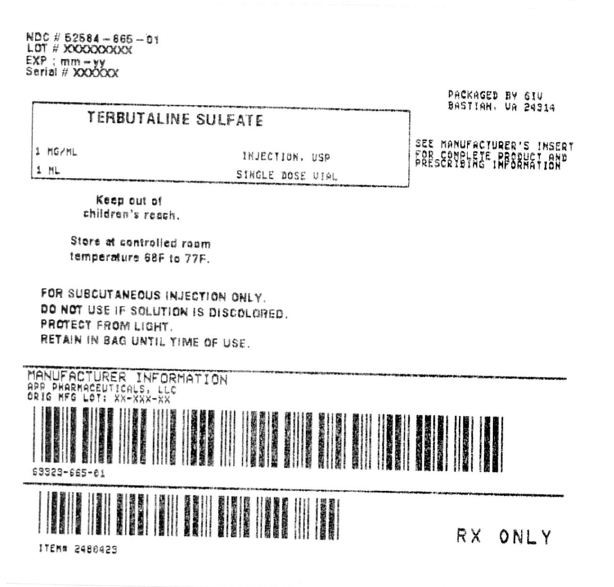Terbutaline Sulfate
General Injectables & Vaccines, Inc
Terbutaline Sulfate Injection, USP 1mg/mL 1mL single dose vial
FULL PRESCRIBING INFORMATION: CONTENTS*
- TERBUTALINE SULFATE DESCRIPTION
- CLINICAL PHARMACOLOGY
- INDICATIONS & USAGE
- TERBUTALINE SULFATE CONTRAINDICATIONS
- WARNINGS
- PRECAUTIONS
- TERBUTALINE SULFATE ADVERSE REACTIONS
- OVERDOSAGE
- DOSAGE & ADMINISTRATION
- HOW SUPPLIED
- PACKAGE LABEL.PRINCIPAL
FULL PRESCRIBING INFORMATION
TERBUTALINE SULFATE DESCRIPTION
Rx only
A sterile aqueous solution for subcutaneous injection.
WARNING: PROLONGED TOCOLYSIS
Terbutaline sulfate has not been approved and should not be used for prolonged tocolysis (beyond 48 to 72 hours). In particular, terbutaline sulfate should not be used for maintenance tocolysis in the outpatient or home setting. Serious adverse reactions, including death, have been reported after administration of terbutaline sulfate to pregnant women. In the mother, these adverse reactions include increased heart rate, transient hyperglycemia, hypokalemia, cardiac arrhythmias, pulmonary edema and myocardial ischemia. Increased fetal heart rate and neonatal hypoglycemia may occur as a result of maternal administration (see CONTRAINDICATIONS, Prolonged Tocolysis).
DESCRIPTION
Terbutaline Sulfate Injection, USP, is a beta-adrenergic agonist bronchodilator available as a sterile, nonpyrogenic, aqueous solution in vials, for subcutaneous administration. Each mL of solution contains: 1 mg of terbutaline sulfate USP (0.82 mg of the free base), and Water for Injection, USP. Sodium chloride is used for isotonicity, and hydrochloric acid for adjustment to a pH of 3.0 to 5.0. Terbutaline sulfate is (±)-a-[(tert-butyl-amino) methyl]-3,5-dihydroxybenzyl alcohol sulfate (2:1) (salt). The structural formula is:

Terbutaline sulfate USP is a white to gray-white crystalline powder. It is odorless or has a faint odor of acetic acid. It is soluble in water and in 0.1N hydrochloric acid, slightly soluble in methanol, and insoluble in chloroform.
CLINICAL PHARMACOLOGY
Terbutaline is a beta-adrenergic receptor agonist. In vitro and in vivo pharmacologic studies have demonstrated that terbutaline exerts a preferential effect on beta2-adrenergic receptors. While it is recognized that beta2-adrenergic receptors are the predominant receptors in bronchial smooth muscle, data indicate that there is a population of beta2-receptors in the human heart, existing in a concentration between 10% to 50%. The precise function of these receptors has not been established (see WARNINGS). Controlled clinical studies in patients given terbutaline subcutaneously have not revealed a preferential beta2-adrenergic effect. The pharmacologic effects of beta-adrenergic agonists, including terbutaline, are at least in part attributable to stimulation through beta-adrenergic receptors of intracellular adenyl cyclase, the enzyme which catalyzes the conversion of adenosine triphosphate (ATP) to cyclic 3’,5’-adenosine monophosphate (cAMP). Increased cAMP levels are associated with relaxation of bronchial smooth muscle and inhibition of release of mediators of immediate hypersensitivity from cells, especially from mast cells. Controlled clinical studies have shown that terbutaline relieves bronchospasm in acute and chronic obstructive pulmonary disease by significantly increasing pulmonary flow rates (e.g., an increase of 15% or more in FEV1). After subcutaneous administration of 0.25 mg of terbutaline, a measurable change in expiratory flow rate usually occurs within 5 minutes, and a clinically significant increase in FEV1 occurs within 15 minutes. The maximum effect usually occurs within 30 to 60 minutes, and clinically significant bronchodilator activity may continue for 1.5 to 4 hours. The duration of clinically significant improvement is comparable to that observed with equimilligram doses of epinephrine.
Preclinical
Studies in laboratory animals (minipigs, rodents, and dogs) have demonstrated the occurrence of cardiac arrhythmias and sudden death (with histological evidence of myocardial necrosis) when beta-agonists and methylxanthines are administered concurrently. The clinical significance of these findings is unknown.
Pharmacokinetics
Subcutaneous administration of 0.5 mg of terbutaline to 17 healthy, adult, male subjects resulted in mean (SD) peak plasma terbutaline concentration of 9.6 (3.6) ng/mL, which was observed at a median (range) time of 0.5 (0.08 to 1) hours after dosing. The mean (SD) AUC (0 to 48) and total body clearance values were 29.4 (14.2) hr • ng/mL, and 311 (112) mL/min respectively. The terminal halflife was determined in 9 of the 17 subjects and had a mean (SD) of 5.7 (2) hours. After subcutaneous administration of 0.25 mg of terbutaline to two male subjects, peak terbutaline serum concentrations of 5.2 and 5.3 ng/mL were observed at about 20 minutes after dosing.
Elimination half-life of the drug in 10 of 14 patients was approximately 2.9 hours after subcutaneous administration, but longer elimination half-lives (between 6 to 14 hours) were found in the other 4 patients. About 90% of the drug was excreted in the urine at 96 hours after subcutaneous administration, with about 60% of this being unchanged drug. It appears that the sulfate conjugate is a major metabolite of terbutaline and urinary excretion is the primary route of elimination.
INDICATIONS & USAGE
Terbutaline Sulfate Injection, USP is indicated for the prevention and reversal of bronchospasm in patients 12 years of age and older with asthma and reversible bronchospasm associated with bronchitis and emphysema.
TERBUTALINE SULFATE CONTRAINDICATIONS
WARNINGS
Deterioration of Asthma
Asthma may deteriorate acutely over a period of hours or chronically over several days or longer. If the patient needs more doses of terbutaline than usual, this may be a marker of destabilization of asthma and requires reevaluation of the patient and treatment regimen, giving special consideration to the possible need for anti-inflammatory treatment, e.g., corticosteroids.
Use of Anti-Inflammatory Agents
The use of beta-adrenergic agonist bronchodilators alone may not be adequate to control asthma in many patients. Early consideration should be given to adding anti-inflammatory agents, e.g., corticosteroids.
Cardiovascular Effects
Terbutaline, like all other beta-adrenergic agonists, can produce a clinically significant cardiovascular effect in some patients as measured by pulse rate, blood pressure, and/or symptoms. Although such effects are uncommon after administration of terbutaline at recommended doses, if they occur, the drug may need to be discontinued. In addition, beta-agonists have been reported to produce electrocardiogram (ECG) changes, such as flattening of the T wave, prolongation of the QTc interval, and ST segment depression. The clinical significance of these findings is unknown. Therefore, terbutaline, like all sympathomimetic amines, should be used with caution in patients with cardiovascular disorders, especially coronary insufficiency, cardiac arrhythmias, and hypertension.
Seizures
There have been rare reports of seizures in patients receiving terbutaline; seizures did not recur in these patients after the drug was discontinued.
PRECAUTIONS
General
Terbutaline, as with all sympathomimetic amines, should be used with caution in patients with cardiovascular disorders, including ischemic heart disease, hypertension, and cardiac arrhythmias; in patients with hyperthyroidism or diabetes mellitus; and in patients who are unusually responsive to sympathomimetic amines or who have convulsive disorders. Significant changes in systolic and diastolic blood pressure have been seen and could be expected to occur in some patients after use of any beta-adrenergic bronchodilator.
Immediate hypersensitivity reactions and exacerbations of bronchospasm have been reported after terbutaline administration. Beta-adrenergic agonist medications may produce significant hypokalemia in some patients, possibly through intracellular shunting, which has the potential to produce adverse cardiovascular effects. The decrease is usually transient, not requiring supplementation. Large doses of intravenous terbutaline have been reported to aggravate pre-existing diabetes mellitus and ketoacidosis.
Drug Interactions
The concomitant use of terbutaline with other sympathomimetic agents is not recommended, since the combined effect on the cardiovascular system may be deleterious to the patient.
Monoamine Oxidase Inhibitors or Tricyclic Antidepressants
TERBUTALINE SULFATE ADVERSE REACTIONS
Adverse reactions observed with terbutaline are similar to those commonly seen with other sympathomimetic agents. All these reactions are transient in nature and usually do not require treatment.
The following table compares adverse reactions seen in patients treated with terbutaline (0.25 mg and 0.5 mg), with those seen in patients treated with epinephrine injection (0.25 mg and 0.5 mg), during eight double-blind crossover studies involving a total of 214 patients.
|
|
Incidence (%) of Adverse Reactions |
|
|
|
Terbutaline (%) |
Terbutaline (%) |
|
|
0.25 mg N=77 |
0.5 mg N=205 |
| Reaction |
|
|
| Central Nervous System |
|
|
| Tremor |
7.8 |
38 |
| Nervousness |
16.9 |
30.7 |
| Dizziness |
1.3 |
10.2 |
| Headache |
7.8 |
8.8 |
| Drowsiness |
11.7 |
9.8 |
| Cardiovascular |
|
|
| Palpitations |
7.8 |
22.9 |
| Tachycardia |
1.3 |
1.5 |
| Respiratory |
|
|
| Dyspnea |
0 |
2 |
| Chest discomfort |
1.3 |
1.5 |
| Gastrointestinal |
|
|
| Nausea/vomiting |
1.3 |
3.9 |
| Systemic |
|
|
| Weakness |
1.3 |
0.5 |
| Flushed feeling |
0 |
2.4 |
| Sweating |
0 |
2.5 |
| Pain at injection site |
2.6 |
0.5 |
|
|
Epinephrine (%) |
Epinephrine (%) |
|
|
0.25 mg N=153 |
0.5 mg N=61 |
| Reaction |
|
|
| Central Nervous System |
|
|
| Tremor |
16.3 |
18 |
| Nervousness |
8.5 |
31.1 |
| Dizziness |
7.8 |
3.3 |
| Headache |
3.3 |
9.8 |
| Drowsiness |
14.4 |
8.2 |
| Cardiovascular |
|
|
| Palpitations |
7.8 |
29.5 |
| Tachycardia |
2.6 |
0 |
| Respiratory |
|
|
| Dyspnea |
2 |
0 |
| Chest discomfort |
2.6 |
0 |
| Gastrointestinal |
|
|
| Nausea/vomiting |
1.3 |
11.5 |
| Systemic |
|
|
| Weakness |
2.6 |
1.6 |
| Flushed feeling |
1.3 |
0 |
| Sweating |
0 |
0 |
| Pain at injection site |
2.6 |
1.6 |
OVERDOSAGE
The median sc lethal dose of terbutaline in mature rats was approximately 165 mg/kg (approximately 2,700 times the maximum recommended daily sc dose for adults on a mg/m2 basis). The median sc lethal dose of terbutaline in young rats was approximately 2,000 mg/kg (approximately 32,000 times the maximum recommended daily sc dose for adults on a mg/m2 basis). The expected symptoms with overdosage are those of excessive beta-adrenergic stimulation and/or occurrence or exaggeration of any of the symptoms listed under ADVERSE REACTIONS, e.g., seizures, angina, hypertension or hypotension, tachycardia with rates up to 200 beats per minute, arrhythmias, nervousness, headache, tremor, dry mouth, palpitation, nausea, dizziness, fatigue, malaise, and insomnia. Hypokalemia may also occur. There is no specific antidote. Treatment consists of discontinuation of terbutaline together with appropriate symptomatic therapy. The judicious use of a cardioselective beta-receptor blocker may be considered, bearing in mind that such medication can produce bronchospasm. There is insufficient evidence to determine if dialysis is beneficial for overdosage of terbutaline.
DOSAGE & ADMINISTRATION
Terbutaline Sulfate Injection, USP should be used only for subcutaneous administration and not intravenous infusion. Sterility and accurate dosing cannot be assured if the vials are not used in accordance with DOSAGE AND ADMINISTRATION.
Discard unused portion after single patient use.
The usual subcutaneous dose of Terbutaline Sulfate Injection, USP is 0.25 mg injected into the lateral deltoid area. If significant clinical improvement does not occur within 15 to 30 minutes, a second dose of 0.25 mg may be administered. If the patient then fails to respond within another 15 to 30 minutes, other therapeutic measures should be considered. The total dose within 4 hours should not exceed 0.5 mg.
Note: Parenteral drug products should be inspected visually for particulate matter and discoloration prior to administration, whenever solution and container permit.
HOW SUPPLIED
|
|
|
|
| Product No. |
NDC No. |
|
| 660501 |
63323-665-01 |
Terbutaline Sulfate Injection, USP, 1 mg/mL in a 2 mL amber, Type 1 glass vial, 25 vials per tray |
PACKAGE LABEL.PRINCIPAL

Terbutaline SulfateTerbutaline Sulfate INJECTION, SOLUTION
| ||||||||||||||||||||||||||||||||||||||||||||||||||||||